I keep reading on the internet about how cruel and dangerous shearing is for sheep. Pictures of bloody lambs, and shearers kicking or punching sheep. There is a small bit of truth in this, but that small bit of truth is what makes the claims so damaging, and unfair. We do shear our sheep at Rescewe, but honestly the experience is nothing like what many have been led to believe.
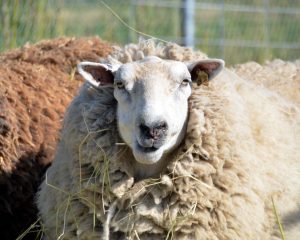
First, let’s address the need for shearing. Most wool sheep need to be sheared. There are select individuals that do shed their wool, and some that can be rooed after wool rise, but most have to be sheared every 6 to 18 months. Contrary to popular belief, some “hair” sheep need to be sheared periodically as well. This is a good point to address the argument that the domesticated wool sheep have no place in the world because they can not survive in the wild. That is pure sheep poop. There are feral wool sheep living in the wild around the world. Most are healthy, happy and do not need shearing. Sure, many sheep could not survive without human management, but we do not want to throw the baby out with the bathwater. That said, for the majority of wool sheep, shearing is still an important safety and comfort concern. Because shearing is a safety and comfort concern, a shepherd must take into account many factors governing when and how often a sheep needs to be sheared. Each breed has its own traits which have to be considered. Flies and wet green pasture in the springtime can require an early Spring shearing. Winter lambing in a cold climate can require an early fall shearing, whereas late spring lambing may require a spring shearing with an early summer retouch. There are many ways it could work out depending on the type of sheep and the conditions they face. At RescEwe, we have different breeds of sheep in our care with breed specific traits, and each has to be managed individually.
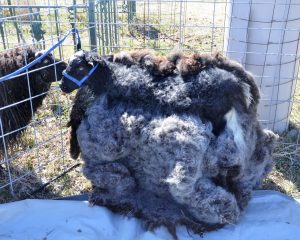
Whenever shearing is done, it is done for the safety and comfort of the sheep as much as the wool they carry. Thick wool is a heavy load to carry around, and can endanger the sheep by making them imbalanced and unable to right themselves if they roll over, or even get up off the ground. Additionally, thick wool can provide a home for external parasites like lice and keds. Soiled wool can give a home to fly maggots that can literally eat a sheep alive (commonly known as flystrike), and that is not a pretty way die. Although all animals should be respected, maggots, lice and keds are not high on our list. As a certified shearer, when I shear in the late Spring/ Summer I will have people feel how warm their sheep are close to the skin. Wool holds in a lot of heat. However, an inch of wool in the Summer can help keep a sheep cooler by keeping the heat out. Finally, there is additional hygiene shearing that may be needed by some sheep at odd times of the year. Crutching, ringing, and dagging are three notable types. Crutching and ringing, are gender specific, the former for ewes, and the latter for rams (I need not say more). Dagging is to remove wool locks that have become soiled by Feces.
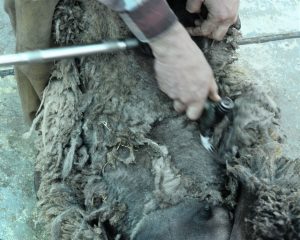
A common myth is that the wrinkles on wrinkly sheep (Merino and Merino crosses mostly) were developed to increase wool quantities. The reason cited is that more skin makes for more wool. That is completely untrue, and this was scientifically documented as early as the 1920’s. Secondly, wrinkled sheep take longer to shear, and any shearer knows that they require more blows (passes with the shearing handpiece). Also, a wrinkly sheep is more likely to be cut in the shearing process, so the progress has to be careful and slower. Frankly, most shearers do not like having to shear wrinkly sheep. They are typically paid by the sheep sheared, and get docked for cut sheep. It is harder to make a living shearing wrinkly sheep. Finally, the staple length for wrinkly sheep is not very consistent across the fleece, making the fiber difficult to spin, hard to class, and the resulting yarn may be prickly. There is no real economic advantage in wool quality or quantity in the wrinkles themselves.
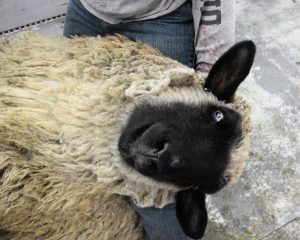
If one looks into the culture of shearing, one will know that abuse and injury is really uncommon. From a producer’s standpoint, stressed and injured sheep are economic poison. Honestly, shearers come along from time to time that carelessly injure sheep, but they do not do it for long. There are producers that brag about having thrown a bad shearer who injures sheep, off their farm. From a shearer’s standpoint, it is a source of pride that they can shear even the most difficult sheep quickly and always without injury. In a lot of ways a shearer is like an athlete, and the better shearers continuously strive to improve their work. Speed without safety is useless. Even in speed shearing competitions, a cutting a sheep means a lower score. Do injuries happen in shearing, without a doubt they do. But even the best dancers sometimes step on their partners feet. Even more so if they are new to each other. One has to figure, a sheep gets sheared typically once a year. After the first time they have a basic understanding of how it is going to work, but there is a learning that can take years. The older sheep who have been through it many times before, are pretty relaxed and resigned to the process. Sometimes lambs are the hardest to shear, because it is all new to them, and new is scary. We take extra time with lambs and try to keep them calm, knowing that the experience will define how they see shearing for the rest of their life.
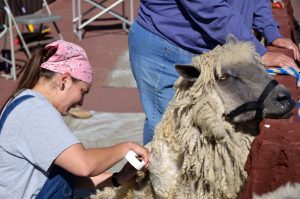
I would like to address how injury is defined at this point. Many shearers will tell you, and the shearing schools teach, that sheep don’t notice sizeable cuts, and forget shearing injuries. This is grossly untrue. As a shearer, I have seen, on too many occasions, a sheep that gets really agitated or fights only at a particular point in the shearing process. Most often one will find, when the wool is removed, old scars left by shearing cuts in those areas. They do feel pain, and they do remember. Sheep are very stoic, and not showing pain or weakness of any kind is one of their survival traits. Under normal situations loosing a patch of skin in the shearing process is not dangerous, nor does it risk the life of the sheep. It is nothing from a health standpoint that a bit of AluShield and flyspray will not fix. However, although the sheep may not show it, the pain is real, and the emotional scars will remain just as surely as the physical scars.
Sheep wool is a unique fiber that has so much to offer. It can be grown in harmony with the environment. Sheep wool has the property of breathability, keeping the wearer warm in winter, and cooler in summer. Wool is bio-degradable and makes a good mulch or fertilizer. Some birds will use wool for nesting material. Wool is naturally hypoallergenic, it has almost the same chemical composition as human hair. Wool is a much more environmentally friendly fiber than synthetic petroleum based fibers or even cotton. Unless you are using organic cotton, cotton is a very “dirty” fiber to produce. According to the USDA, Cotton farmers in the US used 14 million pounds of glyphosate potassium and glyphosate isopropylamine in 2015 alone. And that is just the beginning, There was a large amount of atrazine and other nasty pesticides as well. For the future of our planet, wool is a better choice.
I keep seeing mulesing and shearing being lumped together. Please, do not confuse mulesing, with shearing, as they have no real connection to each other. Mulesing is a barbaric practice used to protect sheep from flystrike, and entails completely removing the skin from the crutch and tail area. The producers that use mulesing are quick to point out, it is the lesser of two evils, because flystrike is a slow and painful way to die. However, there are more humane ways, albeit possibly more labor intensive, and expensive ways to protect sheep from flystrike. Many countries have enacted laws that prohibit mulesing, and some even prohibit the importation of wool from mulsed sheep. Thankfully, it is a practice that is disappearing.
More than the average person wants to know about flystrike, with pictures (take that as a warning), can be found here.
In Conclusion:
Yes, we do shear our sheep, because they need to be sheared for health and safety reasons.
Yes, we do it in the safest way we can, with as little stress as possible.
And yes, all proceeds from the sale of our wool goes to the direct care of the sheep (making your donations go farther). There is nothing wrong with letting the sheep help pay for their hay. After all, many generations of sheep have paid their way with wool.